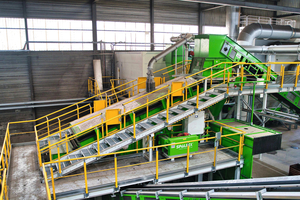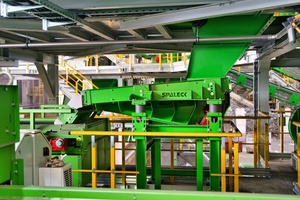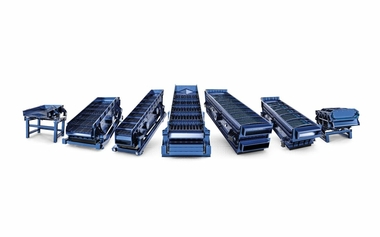Efficient sorting of electronic and electrical waste
The requirements for recycling electronic waste have increased enormously in recent years. On the one hand, the amount of disposal material continues to grow strongly in international terms. On the other hand, consumers, companies and politicians are increasingly realising that there must be a joint rethink. In addition to a reduction of electronic waste, a change in repair behaviour and a rethink of consumption, recycling and reuse must be further promoted.
It is also for this reason that the Swiss recycling specialist Immark has replaced and expanded its previous electronic scrap processing facility at its Regensdorf site with a state-of-the-art recycling plant. What is new here is that Immark can process the material using state-of-the-art technology. The new plant aims to contribute to environmentally friendly recycling with state-of-the-art technology. The focus is on the removal of harmful substances from the electronic scrap as well as the recovery of clean fractions such as iron, various non-ferrous metals and plastics.
Innovative technology optimises
the recycling process
Patrick Wollenmann, team leader for technology at Immark, explains: “The special thing about the system is not only that the latest technology was installed here. In the development of the processing method, we also focused on relieving the manual sorters as much as possible and at the same time achieving the purest possible material fractions.” After all, these are essential for an economical and at the same time environmentally friendly processing of recycling raw materials. Precise screening according to material size is a must for the downstream sorting equipment to sort the material according to material and quality. The „cleaner“ these are supplied, the more efficiently and accurately they can process the material streams.
This means that only by having material streams sorted cleanly by size can the downstream sorting technology subsequently sort with high performance according to material and material properties. Patrick Wollenmann concludes: “Economically and for the environment, it is best if we manage to recycle a wide variety of electrical devices in such a way that in the end very clean individual materials can be recovered from them. This is how we make the greatest contribution to resource recovery and thus to environmental protection.”
A question of material
As a partner for conveying & separation technology, SPALECK was able to contribute to the realisation of the new plant by supplying conveying equipment and screening machines. In order to achieve the desired material purity, a special conveying aggregate from SPALECK was used, among other solutions. Marcel van Reimersdahl, expert for SPALECK screening technology, says: “For the new Immark plant, we used our combination unit, which optimally supplies the downstream optical sorting units.”
In addition to the precisely matched feed width, another important quality component was implemented: The screening of the disadvantageous fine fraction. Marcel van Reimersdahl explains: “The performance of a sorter depends significantly on the material feed. Our continuous and optimal feeding over the entire belt width enables the sorter to perform at its maximum capacity and thus achieve the best return on investment. To achieve even better results, we have eliminated another central cause of malfunction in practice: The contamination of the material by fines.”
For this task, the SPALECK combined system screens out unwanted fines < 8 mm with a special screening panel during feeding. This means that only the material that really fits into the sorting process enters the machine. This can be optimally detected and processed by the sorting device. Screening in the feeding process ensures extremely effective prevention of contamination and sticking of the sorting belt and improves the sorting quality in the long term. “In this way, we manage to achieve very high levels of purity in all fractions with the new processing plant,” says Patrick Wollenmann with pleasure.
High-performance screening
technology customised in advance
At the beginning of the recycling process, after shredding and initial manual sorting, two SPALECK single-deck screens from the German machine manufacturer are also used. Marcel van Reimersdahl: “Already in the planning phase of the project, we carried out comprehensive screening tests together with the Immark team at our SPALECK TestCenter. These tests with Immark material enabled us to test the screening process and the target fractions under very realistic conditions in advance. This allowed us to determine the optimum technical equipment for the screening machines and ensure that very high-quality material fractions are achieved in live operation.”
To be specific, fractions of 20 to 60 mm and 20 to 70 mm are generated. „SPALECK‘s special screening media and efficient screening technology enable us to generate high-quality fractions that meet the requirements of state-of-the-art electronic scrap recycling. It is important for us that we exceed the legal requirements with our new plant and make a contribution to protecting the environment,“ says Patrick Wollenmann with delight. Marcel van Reimersdahl adds: “The Immark team can be very proud of this highly complex and efficient electronic scrap processing plant.”











